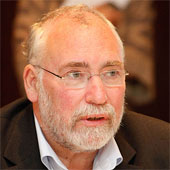China, Arabs and Globalization
Why is the globalization challenge easier for China to tackle than it is for the Arab world?
August 12, 2002
Whenever I teach a class on "globalization," my students are business executives coming from all of the world's major continents and cultures. But they all react in quite different ways to the class.
As a matter of fact, the course material tends to make the representatives from China — including the People's Republic of China, Hong Kong and Taiwan — feel tempted to quietly gloat. In sharp contrast, participants from the Middle East became most uncomfortable.
Witnessing this contrast between the dynamic resurgence of the Confucianist world and the stagnant submergence of the Arab world is truly striking. In part, this reflects today's economic realities.
China, after all, is one of the major actors of contemporary globalization, while the Middle East has been described as its orphan. But just as loudly, this form of characterization speaks to these regions' aspirations — and futures.
Let's look at some numbers. Over the past 20 years, average annual GDP growth in East Asia has been over 6%, while that of the Middle East and North Africa has been –2.3%. China attracts the lion's share of global foreign direct investment (FDI) flowing to developing countries.
The Middle East and North Africa account for less than 1%. China's exports of manufactured goods are composed of about 15% high-technology products. For the Middle East, the corresponding figure is 0.6%.
And yet, I do have good news for my currently very depressed Islamic classroom audiences. Lest we forget, for at least 500 years the Arab world was the locomotive of globalization.
Philosophy, mathematics, science, resplendent art and architecture and truly global trade were among the benefits this Arab civilization bequeathed the world.
Why then does the Arab world wallow today in stagnant irrelevance? We might note a few related paradoxes that could help to answer this question.
During the last 50 years, predominantly Hindu India was a poor economic performer as well. Yet, Hindus are now among the most successful global entrepreneurs —not least in one of its most competitive environments, Silicon Valley.
North Korea and South Korea are both products of exactly the same Confucianist culture as is China. And 40 years ago, both North and South Korea were among the world's poorest countries.
Today, the South is rich — and one of the world's most dynamic societies. The North is an unmitigated disaster.
Similarly, Thailand and Burma are neighbors, both Buddhist cultures with a quite similar heritage. But 40 years ago, Burma was significantly richer than Thailand.
At some point, Burma decided to shut itself off from the world. Thailand, on the other hand, has been one of the world's most open societies.
True, Thailand does face some substantial economic challenges, but the difference between the two countries at the beginning of the 21st century is enormous.
The important difference in all these cases, it seems, is not defined by the culture — Islamic, Confucianist, Christian or whatever it might be.
Rather, it is between those societies that are open, tolerant, pluralistic and driven by intellectual curiosity — and those that are the opposite.
History teaches this lesson quite forcefully. Spain, for example, was a great nation for several centuries. During that time, many of its cities, notably Cordoba, were true crossroads of Christian, Islamic and Jewish cultures.
In the 15th century, however, the Catholic regime became intolerant and dogmatic. It expelled the Jews and the Muslims. And Spain entered a period of five centuries of decline.
It only began to recover from this detour after the death of dictator Francisco Franco (1975) — when, symbolically, it started on a journey of joining (or rejoining) Europe.
Similarly, when Taiwan was a repressive militarist dictatorship, about eight out of every ten Taiwanese who went to study in the United States failed to return.
Following the democratization and general opening that occurred, members of the "Taiwanese Diaspora" returned in droves. They were instrumental in making the island one of the world's most advanced entrepreneurial hubs of information technology.
The situation in the Middle East is totally different. More than anything else, one statistic illustrates not only that the cultural environment is stagnant — but indeed that it has seriously deteriorated.
In the 1950s and 1960s, Egypt was a regional, indeed global, hub of cultural dynamism and thought. Egypt's decline into atrophy has been one of the saddest spectacles of the global intellectual scene of the last four decades.
The statistic I have in mind? Whereas in the 1960s Egypt published an average of 3000 books per year, in the 1990s the number fell to about 300!
The key, then, to the difference between China and the Arab world is not in their cultures. It is in their willingness to embrace certain parts of other cultures — in short their willingness to accept the need to question and to learn from others.
Adoption of a liberal point of view is the main thing that would place Cairo, Damascus and Baghdad back at the center of the global economy that they once dominated.
Read previous
A Global Epidemic in the Making?
August 11, 2002
